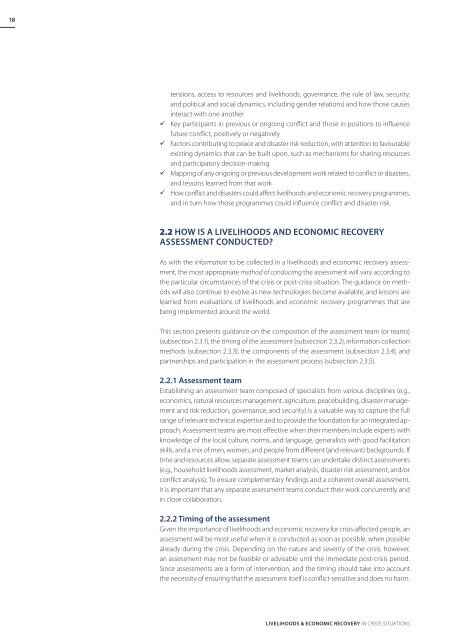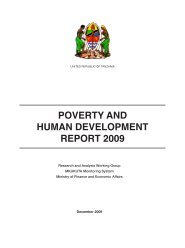Download PDF (4.08 MB) - ReliefWeb
Download PDF (4.08 MB) - ReliefWeb
Download PDF (4.08 MB) - ReliefWeb
You also want an ePaper? Increase the reach of your titles
YUMPU automatically turns print PDFs into web optimized ePapers that Google loves.
18<br />
tensions, access to resources and livelihoods, governance, the rule of law, security,<br />
and political and social dynamics, including gender relations) and how those causes<br />
interact with one another<br />
Key participants in previous or ongoing conflict and those in positions to influence<br />
future conflict, positively or negatively<br />
Factors contributing to peace and disaster risk reduction, with attention to favourable<br />
existing dynamics that can be built upon, such as mechanisms for sharing resources<br />
and participatory decision-making<br />
Mapping of any ongoing or previous development work related to conflict or disasters,<br />
and lessons learned from that work<br />
How conflict and disasters could affect livelihoods and economic recovery programmes,<br />
and in turn how those programmes could influence conflict and disaster risk.<br />
2.2 How is a livelihoods and economic recovery<br />
assessment conducted?<br />
As with the information to be collected in a livelihoods and economic recovery assessment,<br />
the most appropriate method of conducting the assessment will vary according to<br />
the particular circumstances of the crisis or post-crisis situation. The guidance on methods<br />
will also continue to evolve as new technologies become available, and lessons are<br />
learned from evaluations of livelihoods and economic recovery programmes that are<br />
being implemented around the world.<br />
This section presents guidance on the composition of the assessment team (or teams)<br />
(subsection 2.3.1), the timing of the assessment (subsection 2.3.2), information collection<br />
methods (subsection 2.3.3), the components of the assessment (subsection 2.3.4), and<br />
partnerships and participation in the assessment process (subsection 2.3.5).<br />
2.2.1 Assessment team<br />
Establishing an assessment team composed of specialists from various disciplines (e.g.,<br />
economics, natural resources management, agriculture, peacebuilding, disaster management<br />
and risk reduction, governance, and security) is a valuable way to capture the full<br />
range of relevant technical expertise and to provide the foundation for an integrated approach.<br />
Assessment teams are most effective when their members include experts with<br />
knowledge of the local culture, norms, and language, generalists with good facilitation<br />
skills, and a mix of men, women, and people from different (and relevant) backgrounds. If<br />
time and resources allow, separate assessment teams can undertake distinct assessments<br />
(e.g., household livelihoods assessment, market analysis, disaster risk assessment, and/or<br />
conflict analysis). To ensure complementary findings and a coherent overall assessment,<br />
it is important that any separate assessment teams conduct their work concurrently and<br />
in close collaboration.<br />
2.2.2 Timing of the assessment<br />
Given the importance of livelihoods and economic recovery for crisis-affected people, an<br />
assessment will be most useful when it is conducted as soon as possible, when possible<br />
already during the crisis. Depending on the nature and severity of the crisis, however,<br />
an assessment may not be feasible or advisable until the immediate post-crisis period.<br />
Since assessments are a form of intervention, and the timing should take into account<br />
the necessity of ensuring that the assessment itself is conflict-sensitive and does no harm.<br />
Livelihoods & Economic Recovery in Crisis Situations





